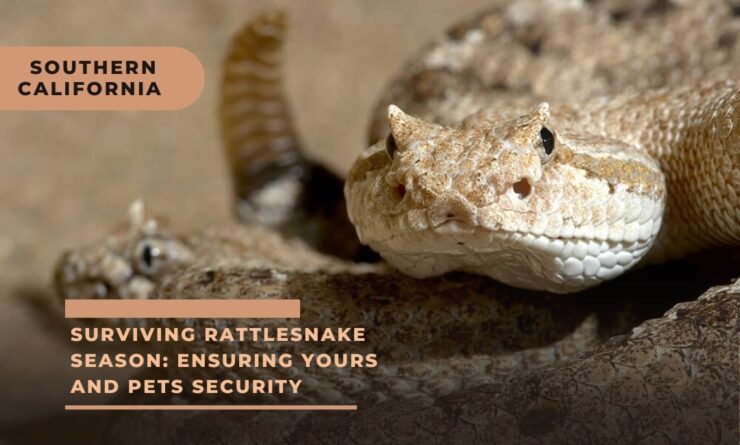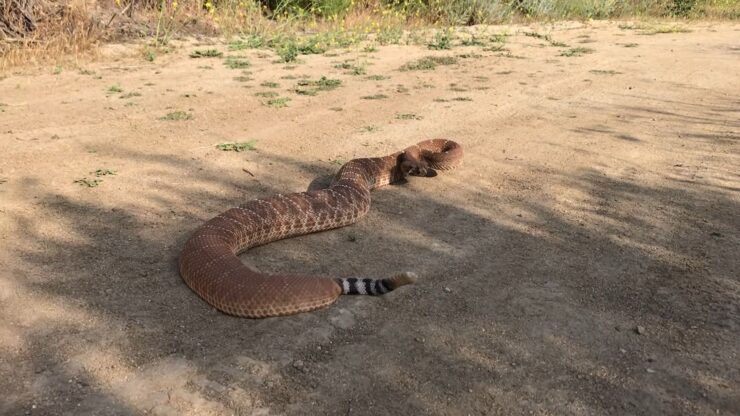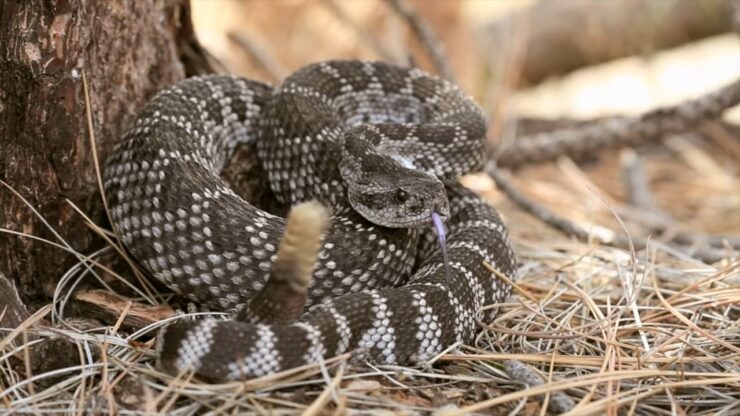Rattlesnakes and California have a common adoration for sunny warmth, wide-open wilderness, and rich resources. These versatile creatures comfortably occupy different parts of the state, from rural landscapes to parks, golf courses, and riverbanks.
They have a knack for finding suitable hideouts, like rock crevices and burrows. However, these cold-blooded creatures need to soak up the sun to manage their body temperatures, making them sometimes visible on roads or trails.
Their active period peaks during summer, with them basking in daylight and hunting at dusk. As the weather cools, they retreat to their burrows, slowing their heart and breathing rates to save energy.
They’re loners for the most part, but space constraints might make them share burrows with other reptiles. Don’t be surprised to find them tucked away in basements and storage sheds, escaping the chilly outdoors.
Rattlesnake Varieties Found in California
- California plays host to seven unique rattlesnake species:
- The Mohave rattlesnakes (Crotalus scutulatus), the most dangerous of the lot, call the desert and foothills of southeastern California home.
- The Panamint rattlesnakes (C. stephensi) prefer the inland desert areas of Southern California.
- The red diamond rattlesnakes (C. ruber), though not large in number, can be spotted from Baja California to just south of Los Angeles.
- The smallest rattlesnakes, the Sidewinders (C. cerastes), live in desert areas up to 6,000 feet.
- The speckled rattlesnakes (C. mitchellii) are another desert-loving species, residing from Baja California to the Colorado, Mojave, and Sonoran Deserts.
- The western diamond-backed rattlesnakes (C. atrox) are surprisingly scarce in California, found mostly in southeastern desert regions.
- Lastly, the western rattlesnakes (C. oreganus) are ubiquitous throughout California, with their three subspecies spread across the state.
Recognizing a Rattlesnake
Whether it’s a three-foot sidewinder or a six-foot western diamond-backed, a rattlesnake can always be identified by its triangular head and the distinctive rattle on its tail.
The rattle, made of keratin, grows with every skin shedding. These creatures have rough, earth-toned scales for camouflage and possess pits on their heads, which are temperature-sensitive and assist in nocturnal hunting.
When a rattlesnake bites, it doesn’t always inject venom – some are “dry bites” used to fend off larger threats without wasting energy on venom production. But one can never be too careful; all bites should be assumed venomous and require immediate medical attention.
Preventing and Surviving Encounter
Rattlesnakes are mostly reclusive and prefer avoiding human interaction. Most bites occur when people unwittingly cross paths with them or try to handle them. Here are some guidelines to avoid a rattlesnake bite and what to do if bitten:
Preventing a Rattlesnake Bite
- Be vigilant in warm weather as snakes are most active then.
- Stick to marked trails, avoid venturing off into vegetation or rocks, and don’t wander around after dark.
- Wearing long pants and closed shoes can provide some protection.
- Be cautious when handling outdoor items and listen out for the unmistakable rattling sound.
- If you come across any snakes or snake-like objects, steer clear.
- Rattlesnakes are surprisingly good swimmers, so don’t pick up random sticks or branches in bodies of water.
- Keep your yard well-trimmed, and always leash your pets during walks.
Surviving a Bite
- Stay composed, call for help immediately, and avoid self-treatments like incisions or icing the wound.
- Wash the bite area with soap and water and remove any potentially constricting items from the affected limb.
- Use a snakebite kit’s suction device to draw out venom if available.
- Safely transport the victim to the nearest medical facility without speeding. If your pet gets bitten, rush it to an emergency vet.
- Take heart knowing that the majority of rattlesnake bite victims recover fully within a few days.
- More people succumb to bees, wasps, and scorpions than snakes annually in the US.
By following precautionary measures and knowing how to respond to a snakebite, you can safely coexist with these formidable creatures.
Source:
https://abc7.com/rattlesnake-season-2023-socal-southern-california-pet-safety/13286282/
















